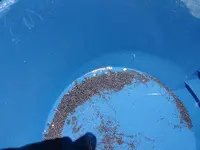AllenJ –
Great looking gold! Looks like you’ve got a great spot.
There are many small creeks and runoff areas here in California where we encounter lots of “woody” materials – These areas also have quite a bit of gold. When I’m using a Recon or Expedition in these conditions I understand that I will be spending time keeping the grizzly clear and cleaning and resetting the sluice more frequently than normal.
I need to mention that the grizzly of the AMP sluices is a water/material limiter first and a classifier second. That means that as the grizzly gets clogged you are reducing material processing speed, not recovery. Realizing that processing material would create a clogging of the grizzly, I built in about 5-10% more surface area into it. Over 10% of the grizzly would have to be covered before any real reduction happens.
Bottom line: When working in the material you discussed, keep the grizzly clean as you process material. When you think its too clogged and sweeping material off with your hand isn’t working just clean and reset the sluice – It takes about 40 seconds for an Expedition. Smaller classification size will certainly reduce the problem but you have to weigh time spent clearing the sluice vs. time spent classifying. Remember classifying one five gallon bucket of quarter-inch mesh is like classifying four buckets of half-inch mesh – concentration of gold in each bucket has benefits!
Arizau -
I want to stress the importance of laminar flow in fluidized systems like the Expedition (and I assume the Bazooka/GGT). The material liquefies and stratifies as it travels down the material deck. A mesh strainer will fill up very quickly with material causing reduced and irregular flows - Any impedance in the flow or addition of turbulence can disrupt the stratification and liquefaction process which can result in reduced recovery.




